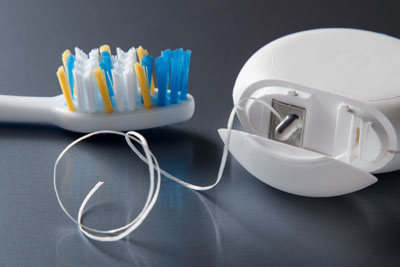
The different types of floss and tips for flossing make it possible to keep the tight spaces between teeth free of food particles and plaque. That goes a long way when it comes to fighting tooth decay. Dental floss is used to remove the plaque, food particles and bacteria that become lodged between teeth after meals. While some of this debris will be eventually washed away by saliva, the rest can be lodged between teeth.
Keeping the spaces between teeth keeps gum disease and tooth decay away. Those who fail to floss daily remain vulnerable to common oral diseases even if they brush their teeth twice a day. The bristles of a toothbrush simply cannot reach the tight spaces between teeth. Fortunately, there are different types of floss and tips for flossing that make it possible to keep these areas clean.
What dental floss is made from
Dental floss has been used as far back as the 1800s. It was often made out of silk back then, but modern floss is typically made from plastics that are liquefied and stretched into thin strands. These plastic floss materials are much stronger than silk or other textiles. Other materials like flavoring and wax are often added to make flossing a more pleasant affair.
Different types of floss and tips for flossing
1. Standard floss
This is the common type of floss that comes to mind when the topic comes up. However, there is lots of variety. Some are waxed or flavored with mint to increase their appeal. While it is normal to be fixated on the type of floss one decides to use, what really matters is the flossing technique used.
There is a noteworthy difference when it comes to waxed or un-waxed floss, though. The former slides through tight spaces much easier.
2. Floss picks
Floss picks are arguably the most convenient way to floss. The handle holds the floss for the person, so only one hand is required to floss. Having the floss held in place by the handle also makes it easier to floss the back of the mouth.
However, floss picks are not as effective as regular floss. It does not fully form a "C" enclosing the tooth, so it does not scape its surfaces as effectively.
3. Oral irrigators
Also known as dental water jets, oral irrigators are flossing tools that use a high-pressure stream of water to remove food particles and plaque between teeth. It also helps to improve the health of the user's gums. Oral irrigators are easy devices to use as well. The user simply puts it in their mouth, and the device does the rest. It is best to close the lips once the machine is inserted to prevent water from splashing out while it cleans.
Contact one of our dentists to learn more about the different types of floss and learn flossing tips.
Let's get started …
For more information or to schedule an appointment with Garden State Healthy Smiles PC, request an appointment in our Long Branch dental office here: https://www.dentistinlongbranch.com. Or call us at (732) 504-6914.
Related Posts
Removing the Bacteria Beneath Tartar for Oral Hygiene
Wondering how to remove oral bacteria so you can have better oral hygiene? It really is a good idea for you to do everything possible to support your good oral health. When you take good …
Foods to Help Heal Cavities Naturally
Cavities are a common occurrence, and dental fillings are usually the preferred solution to tooth decay, regardless of how minor the decay may be. More severe cavities, those that have reached the nerves and are …
Ask a Dentist: Are Electric Toothbrushes Really Better for Your Teeth?
The best way to keep your dentist visits uneventful is with good oral habits. Brushing and flossing twice a day is arguably the most important of these habits. But it is not enough to simply …
The Benefits of Chewing Sugar-Free Gum
Most dentists agree that chewing sugar-free gum is beneficial for the health of teeth! Many people group gum chewing into the same group as candy. However, this is hardly the case when it comes to …
